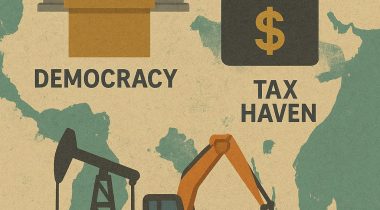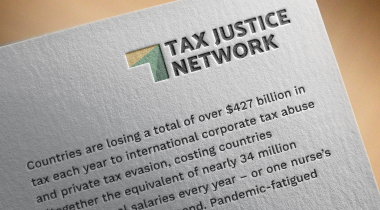
Andres Knobel ■ The Achilles heel of effective beneficial ownership registration: Why is everyone fixed on 25%?

Civil society and allies are pushing for real (and useful) transparency when it comes to disclosing the beneficial owners (BOs) of companies, meaning the individuals who ultimately own and control the companies that operate in our economies, and that could be involved in illegal activities (e.g. tax evasion, corruption, money laundering, etc.).
After many scandals, including the Panama Papers, the international community is moving in that direction, with the G20, the OECD, the Global Forum, the EU and many countries starting to regulate and require beneficial ownership registration. 
So, did we finally win? Far from it. Now the battle now is trying to make sure that this information will cover all companies (and other structures such as trusts), and that this information will be public, along with other necessary details (e.g. information should be held in one central registry available in open data format, etc.).
But…the Achilles heel of this whole process is obviously the definition of a “beneficial owner” (BO).
While there is no doubt that a BO should always be an individual, the question is which, and how many should be identified.
From the UK law on BO registration, to the EU’s 4th Anti-Money Laundering Directive and the OECD’s Common Reporting Standard (as well as the U.S’s IGAs, or Inter-Governmental Agreements related to FATCA) for automatic exchange of banking information, they all refer to the 25% ownership threshold, or even worse, to the “more than” 25% of ownership. (In some cases, 25% could also be applied to those with voting rights, not only to shareholdings).
This “more than 25% threshold” means in practice that any company with at least four shareholders (e.g. two parents and two children or four friends) with equal shareholdings or voting rights will have no beneficial owner at all because none of them would trigger registration requirements – each shareholder would “merely” have 25%.
You may think that’s not too bad, because some companies listed in a stock exchange may have thousands of shareholders, making the whole thing too complex. True, but listed companies are generally not covered by this regulation (besides the requirement that a clearing institution should know who each shareholder of a listed company is, and so it’s clearly not that complex).
You may also think that many legitimate companies only have one or two owners, and so this regulation isn’t too bad in practice. True, and they very likely already appear as ultimate owners, if they’re not using bearer shares, nominees or offshore companies deployed by those trying to remain hidden. So, they are not the problem anyway.
The problem is that any criminal (the real target of this regulation) will simply get together with three others, and thus easily avoid being identified.
So how did the Achilles heel of 25% become so sacrosanct?
Funnily enough (but definitely not funny haha) the Financial Action Task Force Recommendations on Anti-Money Laundering (which are also referred to in the Common Reporting Standard) only ever just mentioned this “more than 25% threshold” as an example or suggestion within another example or suggestion!
Controlling shareholders as referred to in, paragraph 5(b)(i) of the interpretive note to Recommendation 10 may be based on a threshold, e.g. any persons owning more than a certain percentage of the company (e.g. 25%). [2012 FATF Recommendations, page 86; emphasis added]
So, is this “example within an example” binding on all countries? Obviously not! It is a mere suggestion and plenty of other countries and institutions already use lower thresholds. For example:
a) Argentina’s 20% threshold for BO (called “beneficiario final” in Spanish)
Se entiende como beneficiario final a las personas humanas que tengan como mínimo el veinte por ciento (20%) del capital o de los derechos de voto de una persona jurídica o que por otros medios ejerzan el control final, directo o indirecto sobre una persona jurídica u otra estructura jurídica (art. 510 inc. 6 de la RG 07/15)
b) Bermuda’s 10% threshold
Yes, even Bermuda requires all companies to provide beneficial ownership information to the Bermuda Monetary Authority (BMA), prior to their registration. Bermuda’s Corporate Service Provider (Beneficial Owner) Regulations 2012 establish that:
Meaning of beneficial owner. 3(1) In the case of a body corporate, “beneficial owner” means any individual who—(a) as respects any body other than a company whose securities are listed on an appointed stock exchange, ultimately owns or controls (whether through direct or indirect ownership or control, including through bearer share holdings) more than 10% of the shareholding or voting rights in the body; [emphasis added]
c) The U.S. Securities Exchange Commission regulations: 5%
Schedule 13D is commonly referred to as a “beneficial ownership report.” The term “beneficial owner” is defined under SEC rules. It includes any person who directly or indirectly shares voting power or investment power (the power to sell the security).
When a person or group of persons acquires beneficial ownership of more than 5% of a voting class of a company’s equity securities registered under Section 12 of the Securities Exchange Act of 1934, they are required to file a Schedule 13D with the SEC. [emphasis added]
d) Switzerland’s Federal Act on Financial Market Infrastructures: 3%
Art. 120: “Anyone who directly or indirectly or acting in concert with third parties acquires or disposes of shares or acquisition or sale rights relating to shares of a company with its registered office in Switzerland whose equity securities are listed in whole or in part in Switzerland, or of a company with its registered office abroad whose equity securities are mainly listed in whole or in part in Switzerland, and thereby reaches, falls below or exceeds the thresholds of 3%, 5%, 10%, 15%, 20%, 25%, 33?%, 50% or 66?% of the voting rights, whether exercisable or not, must notify this to the company and to the stock exchanges on which the equity securities are listed”. (emphasis added)
e) Extractive Industries Transparency Initiative (EITI) pilot projects for the extractive industries: no threshold or 5%
-Burkina Faso: no threshold (any owner is a BO)
–Ghana: no threshold
–Honduras: 5 %
–Kyrgyz Republic: 5% (or no threshold for politically exposed persons or PEPs)
-Liberia: 5% (oil & mining), 10% (forestry). If no one passes the corresponding threshold (5% or 10%), the top 5 shareholders have to be identified
-Tajikistan: 5%
–Zambia: no threshold or 5% (proposed)
Sources: EITI 2015 Beneficial Ownership Pilot Evaluation Report, pages 6-10.
So, if the Financial Action Task Force never even said that the threshold should only be at most “more than 25%”, why are so many now considering that this is a must?
As we’ve just demonstrated above, other countries – including the famous tax haven of Bermuda – know better.
There is one way to at least address everyone’s concerns: if a company has no apparent BOs (because all shareholders are below the threshold), then at least require registration as BOs of all of the top four shareholders (who would collectively hold 25% each) because they should all be considered to have significant influence over the entity. What if 20 shareholders have 5% each? Then all of them should be identified, because they all have equally significant influence over the company.
If countries really want to improve transparency, they shouldn’t be making life easier for people wanting to remain hidden. If someone tries to create a complex and sophisticated ownership structure to avoid BO registration, that should be a burden on them, not a benefit.
Related articles

‘Illicit financial flows as a definition is the elephant in the room’ — India at the UN tax negotiations

Tackling Profit Shifting in the Oil and Gas Sector for a Just Transition

Follow the money: Rethinking geographical risk assessment in money laundering

Democracy, Natural Resources, and the use of Tax Havens by Firms in Emerging Markets
One-page policy briefs: ABC policy reforms and human rights in the UN tax convention

The Financial Secrecy Index, a cherished tool for policy research across the globe

When AI runs a company, who is the beneficial owner?
Insights from the United Kingdom’s People with Significant Control register
13 May 2025

Uncovering hidden power in the UK’s PSC Register



İt woul be interesting to know Your opinion, why Switzerland’s Act differs BO’s category in so many ways: 3%, 5%, 10%, 15%, 20%, 25%, 33⅓%, 50% or 66⅔%